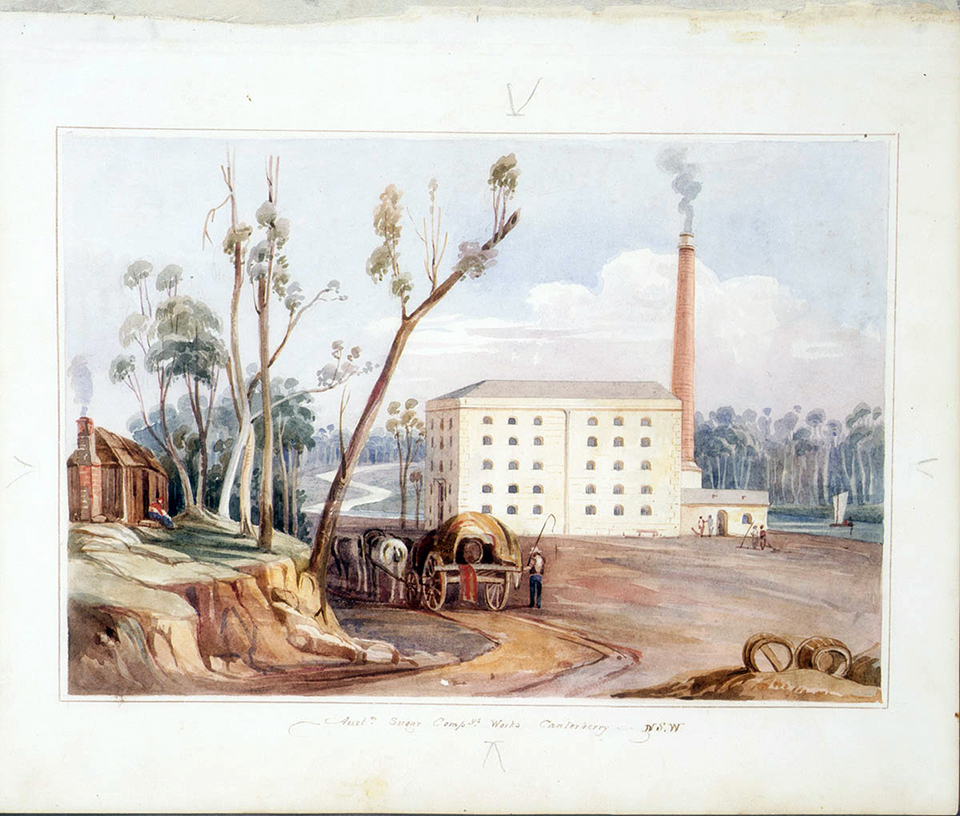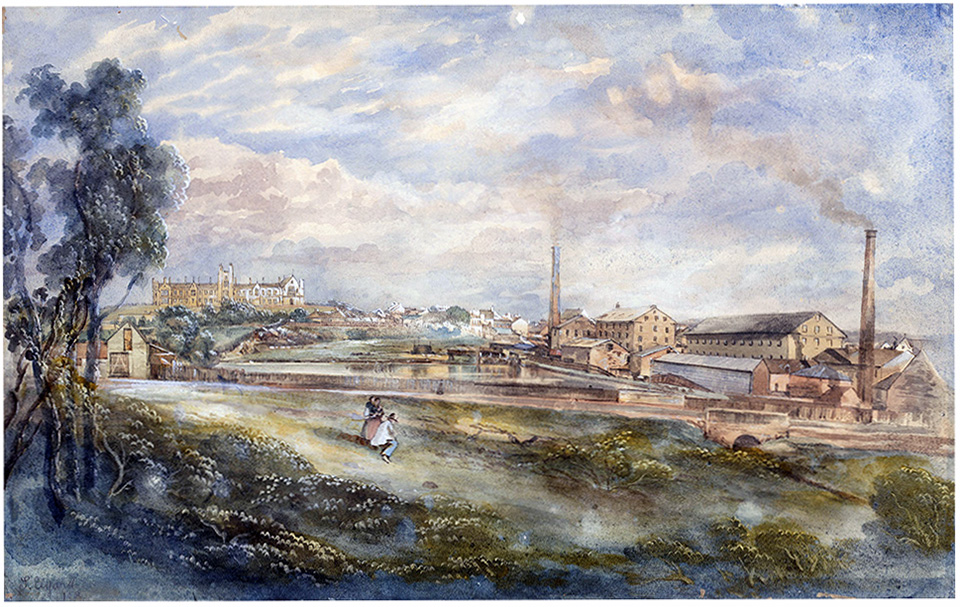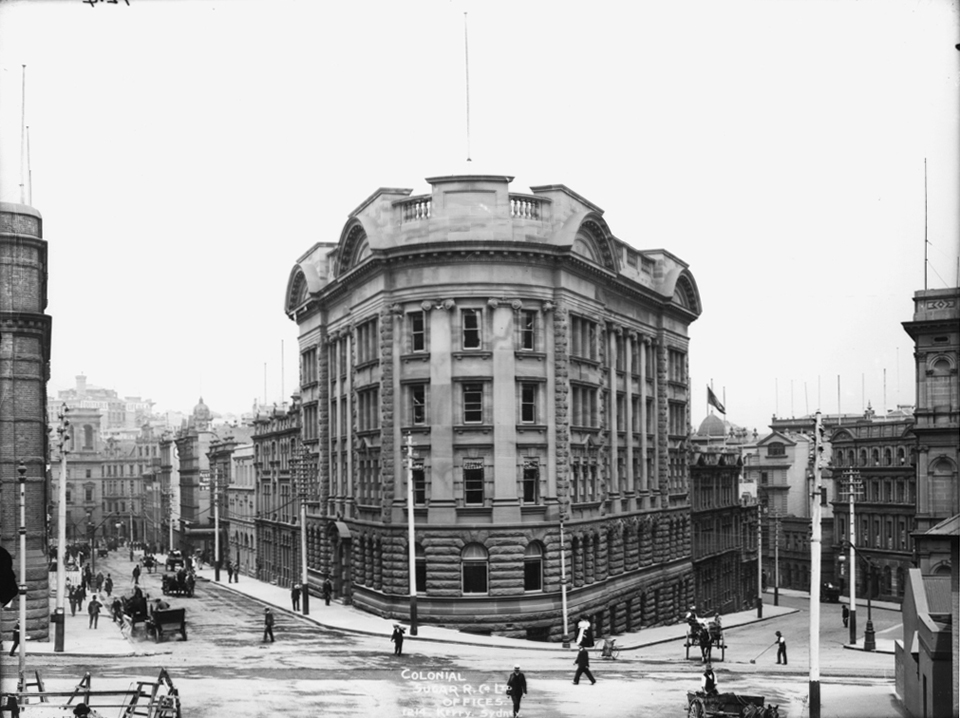The Dictionary of Sydney was archived in 2021.
Colonial Sugar Refining Co Ltd
Citation
Persistent URL for this entry
To cite this entry in text
To cite this entry in a Wikipedia footnote citation
To cite this entry as a Wikipedia External link
Colonial Sugar Refining Co Ltd
The Colonial Sugar Refining Co Ltd was founded in 1855 by Sir Edward Knox, who was born in 1819 at Helsingör, Denmark, and had come to Australia in February 1840. After a variety of business experiments in Sydney, in 1843 he bought a sugar [media]refinery and a distillery, which he leased to the Australasian Sugar Co, which had been manufacturing sugar in Sydney since 1842 and had plants at Canterbury and in the city, at the corner of Liverpool and Pitt streets. Then, in 1854 that company went into liquidation, and on 1 January 1855 Knox founded the Colonial Sugar Refining Co (CSR), holding a third of its capital of £150,000 and acquiring the assets of the former company.
CSR in Chippendale
[media]Due probably to labour shortages for the Canterbury refinery, CSR moved some of its operations to another site, in Chippendale. While the move of the refinery there undoubtedly brought more stable employment opportunities to the area, it also brought greater environmental problems. These arose from two sources – the burning of bones to create charcoal for filtering purposes, and the company's maneuvering to ensure a constant cheap water supply. Residents from nearby suburbs deluged the City Council with petitions against the effects of bone-burning: one complained of
a poisonous matter…thrown off in a liquid state and also as a vapour infecting the purity of the atmosphere. [1]
The water problem largely revolved around an old dam on the property which had silted up. CSR attempted to obtain a city water supply for the works, which would have been at the cost of a constant supply to other locals. This took years to resolve.
For two years the company flourished and was able, in 1856, to declare a dividend of 50 per cent. The colonial market was lucrative, and expansion seemed to offer good prospects: in 1857 the Victoria Sugar Co was formed, with half the capital subscribed by CSR shareholders and half by Victorian merchants.
The move to Pyrmont
The unresolved issue of water supply grew over time, and water supply to the company was metered from 1872, resulting in steeper charges and affecting profitability. This undoubtedly encouraged CSR to consider moving its refinery away from an area with increasingly pesky residents. In 1875 CSR started to build at the end of the Pyrmont peninsula, an area dominated by industrial and maritime industries; it became one of the defining industries of the area.
Early in that year, the company had become aware that an unidentified individual had acquired land at Pyrmont to set up a sugar refinery. Possibly fearing a competitor, and being expert in subverting competition, by the end of the year CSR had acquired five acres (two hectares) at the end of the peninsula. Eventually, the CSR complex included three distinct plants. The sugar refinery, which took two years to build and started operations in 1877, initially took sugar cane from Queensland and produced sugar, golden syrup and molasses. The distillery, built on land across Jones Street from the main refinery, commenced operation in 1901, and at one stage supplied half of Australia's industrial alcohol needs and about a third of its rum requirements. The caneite factory, built in 1936, pressed cane sugar fibre into new building materials called caneite and particle board. Eventually, there was also a laboratory on site.
CSR expands
[media]Under Knox's leadership, refineries were established in other Australian colonies and New Zealand, and mills were built to crush cane from independent farmers in New South Wales, Queensland and later Fiji. Then, reflecting both the growth of the company and demand for its products, in July 1887 the company was incorporated in New South Wales as a public company, The Colonial Sugar Refining Co Ltd (CSR Co). It expanded its activities, operating mills and refineries and acting as agents for the Queensland government. It also controlled the export marketing of all refined sugar from Australia: in 1915 the Colonial Sugar Refining Company (Fiji and New Zealand) Limited was formed to take over the assets of CSR Co outside Australia.
Working for CSR
In the mid-nineteenth century, Pyrmont was isolated from the city, and early development in the area was generally related to waterfront industries, including shipyards: the establishment of the Australian Steam Navigation Company shipyard on Darling Island, plus several other industrial enterprises, brought a residential population of workers to the area. The opening of the Pyrmont Bridge across Darling Harbour in the 1850s facilitated new developments and several large businesses, other than CSR, were established there in the later nineteenth century. The CSR sugar refinery was the largest single workplace, in area and staff, on the Pyrmont/Ultimo peninsula, and its activities shaped development in the area. With a few notable exceptions, residential development remained largely working-class, and diminished as the new industries expanded.
Working for CSR was not all 'beer and skittles': as with all heavy industrial work, the work could be both highly dangerous and, in the long run, decidedly unhealthy. Evidence at a Royal Commission into the sugar industry in 1912 told of
The ill effects of the terrific heat, and the change from that heat into draughts, which may occur at any time, and working in cold water and hot water swishing over them at all times. There are diverse weaknesses peculiar to the men who work in different parts of the refinery; they are all affected by what is called toe-rot; their toes get in such a condition that they are never dry, and are pulpy and nasty… [2]
Perhaps of more concern was the suggestion that because of the chemicals released by the various processes, boys who worked in the washhouse 'never reached a proper state of maturity…' [3]
Changes on the peninsula
Further land and, where necessary, the intervening street reservations, were purchased, and in 1906 the site was reorganised with the new main entrance located on Bowman Street, opposite Jones Street. The Main Office built in 1906, is a domestically styled Federation Queen Ann Style building.
By the 1920s, CSR had also purchased over 20 houses near the refinery and was using them for subsidised housing for staff: this increased to about 70 houses in 1939, and the total land holdings had increased to 31 acres (12.5 hectares) by 1957. Some of these were pulled down to create parking areas for the large CSR workforce, which now commuted by car.
CSR started diversifying out of sugar refining, milling and distillery operations in 1936, initially with caneite, and then continued into the building materials business and then mining and, later, chemicals and other interests. By the 1960s, it had started mining bauxite, alumina, aluminium, petroleum and other minerals.
After World War II, however, most industries in Pyrmont-Ultimo either ceased operating or moved to other locations, and in the 1980s CSR began investigating the benefits of relocating from Pyrmont. This was put into effect in the early 1990s, and by 1995 the Pyrmont refinery was closed, and the site was sold to the development company Lend Lease in 1996. CSR now has factories and enterprises around Australia. Detailed heritage interpretation and physical elements of the old site have been incorporated into the new residential development.
References
AG Lowndes, 'Knox, Sir Edward (1819–1901)', Australian Dictionary of Biography, vol 5, Melbourne University Press, Melbourne, 1974, pp 38–39
S Fitzgerald and H Golder, Pyrmont and Ultimo: under siege, Halstead Press, Sydney, 2009
S Fitzgerald, Chippendale: beneath the factory wall, Halstead Press, Sydney, 2008
'CSR Main Office Building (former)', Heritage Database item, New South Wales Heritage branch website, http://www.heritage.nsw.gov.au/07_subnav_01_2.cfm?itemid=2424789, viewed 26 February 2009
Notes
.





